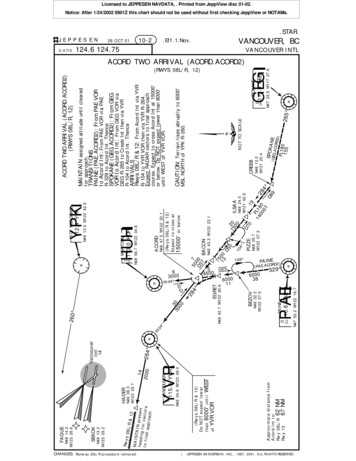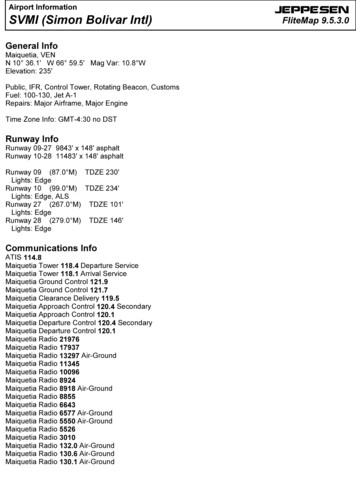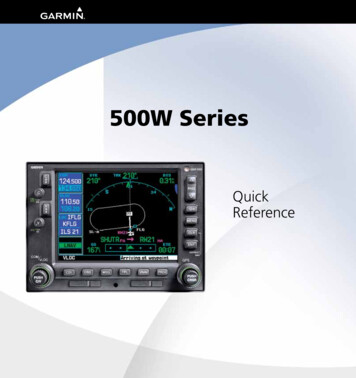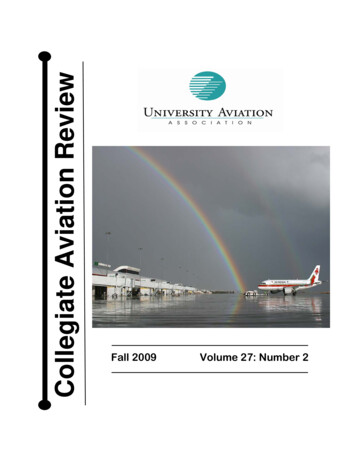
Transcription
Weather Help - Aviation HazardsIcing MapsIcing AreasIcing conditions are depicted using solid fill colors. Light icing is depicted in green,moderate icing is depicted in yellow, and severe icing is depicted in red. The type oficing is not depicted, only the intensity of expected icing conditions. Icing conditionsare predicted using the WRF numerical model for U.S. areas, and the GFS numericalmodel for global areas. The icing forecast algorithm used is a blend of model supercooled liquid water with the NCAR/RAP and Stovepipe algorithms.Freezing LevelsWhite dashed lines indicate the freezing level contours as determined fromobservations and numerical forecast model data. Contour intervals are labeled inhundreds of feet and drawn at 4000 foot intervals on most maps. Regional U.S. mapsmay have freezing level contours at 2000 foot intervals.Icing ReportsOn U.S. maps and areas where PIREP reports are received, PIREPs containing icingare depicted in light blue. For U.S. maps, only the icing severity symbol is depicted atthe report locations. For Regional U.S. maps, other information from the PIREP maybe included, such as: Flight Level in hundreds of feet, aircraft type and time of reportin UTC, outside air temperature in degrees Celsius, and the intensity and type of icingreported. An icing symbol represents the intensity of icing. The diamond shapeindicates the position of the aircraft when the report was issued.AIRMETSOn U.S. maps and areas where AIRMETs are issued for, icing AIRMETS are graphicallydepicted as solid light blue lines. The intensity of the expected icing is depicted usingicing symbols. The altitude range of the icing is labeled to the right of the icingsymbol, with the upper altitude to the upper right, and the lower altitude to the lowerright. Altitudes are labeled in hundreds of feet. FRZLVL is used to indicate that theactual freezing level is the lower altitude limit of icing. The start and expiration timeof the AIRMET is depicted below the icing symbol, with the two digit day of monthfollowed by the 4 digit hour and minute in UTC. Icing AIRMETS (name ZULU) areissued for areas expected to experience moderate icing conditions (outside convectiveactivity).U.S. Maps are available for forecast periods: 00, 03, 06, 12, 18 and 24 hours. The 00 (analysis) map isupdated every hour and is available at the top of the hour, approximately 60 minutes past the analysis time.The 03 and 06 hour maps are updated every 3 hours (based on model data from 00, 03, 06, 09, 12, 15, 18and 21 UTC) and are available approximately 60 minutes past the model run time. The 12, 18 and 24 hourmaps are updated every 6 hours (based on model data from 00, 06, 12, and 18) and are availableapproximately 5-6 hours past the model run time.International maps are available for forecast periods: 12, 18 and 24 hours. Maps are updated every 6 hours(based on data model data from 00, 06, 12 and 18 UTC) and are available approximately 5-8 hours past themodel run time.
Turbulence MapsTurbulence AreasTurbulence conditions are depicted using solid fill colors. Light turbulence is depictedin green, moderate turbulence is depicted in yellow, moderate to severe turbulence inred, and severe turbulence is depicted in purple. Turbulence areas are predicted usingthe WRF numerical model for U.S. areas, and the GFS numerical model for globalareas. The turbulence prediction algorithm is based on the kinematic approach ofEllrod-Knapp-2.Wind SpeedWind speed contours (isotachs) are drawn at 20 knot intervals, starting at 70 kts onmaps with a 5000 foot vertical layer. The wind speed is derived from numerical modeloutput at an altitude within the layer of the map. On composite layer maps, themaximum wind speed can occur at any altitude, but is generally found at higheraltitudes near the jetstream.Turbulence ReportsOn U.S. maps and for areas where PIREPs are received, PIREPs containing turbulenceare depicted in light blue. On U.S. maps only the turbulence intensity indicator is
displayed. On Regional U.S. maps, additional information may be included, such as:Flight Level in hundreds of feet, aircraft type and time of report in UTC, and theintensity of turbulence reported. A turbulence symbol also represents the intensity ofturbulence. The diamond shape indicates the position of the aircraft when the reportwas issued.AIRMETSTurbulence AIRMETS are graphically depicted as solid light blue lines. The intensity ofthe expected turbulence is depicted using turbulence symbols. The altitude range ofthe turbulence is labeled to the right of the turbulence symbol, with the upper altitudeto the upper right, and the lower altitude to the lower right. If the lower altitude isnot present, it is understood that the ground represents the lower limit. Altitudes arelabeled in hundreds of feet. The start and expiration time of the AIRMET is depictedbelow the turbulence symbol, with the two digit day of month followed by the 4 digithour and minute in UTC. Turbulence AIRMETS (named TANGO) are issued for areasexpected to experience moderate turbulence (outside of convective activity).U.S. Maps are available for forecast periods: 00, 03, 06, 12, 18 and 24 hours. The 00 (analysis) map isupdated every hour and is available at the top of the hour, approximately 60 minutes past the analysis time.The 03 and 06 hour maps are updated every 3 hours (based on model data from 00, 03, 06, 09, 12, 15, 18and 21 UTC) and are available approximately 60 minutes past the model run time. The 12, 18 and 24 hourmaps are updated every 6 hours (based on model data from 00, 06, 12, and 18) and are availableapproximately 5-6 hours past the model run time.International maps are available for forecast periods: 12, 18 and 24 hours. Maps are updated every 6 hours(based on data model data from 00, 06, 12 and 18 UTC) and are available approximately 5-8 hours past themodel run time.
IFR AIRMETSAIRMETSIFR and Mountain Obscuration AIRMETS are graphically depicted as solid yellow lines.The type of AIRMET is labeled as either IFR or MTOS (Mountain Obscuration). Thestart and expiration time of the AIRMET is depicted below the AIRMET label, with thetwo digit day of month followed by the 4 digit hour and minute in UTC. IFR &Mountain Obscuration AIRMETS (named SIERRA) are issued for areas where IFR ormountain obscuration conditions are expected over 50% of the defined area.Maps are updated every hour and are available between 30 and 45 past each hour.
SIGMETS and Convective SIGMETSSIGMETSAll current SIGMETS are graphically depicted with solid YELLOW lines. The SIGMETname is depicted with a line pointing to the area. The start and expiration time of theSIGMET is depicted below the name, with the two digit day of month followed by the4 digit hour and minute in UTC. SIGMETS are issued for severe or extreme nonconvective turbulence or icing conditions.ConvectiveSIGMETSAll current Convective SIGMETS are graphically depicted with solid RED lines. TheConvective SIGMET name is depicted with a line pointing to the area or line. The startand expiration time of the Convective SIGMET is depicted below the name, with thetwo digit day of month followed by the 4 digit hour and minute in UTC. ConvectiveSIGMETS are issued for any of the following conditions: severe thunderstorms,embedded thunderstorms, lines of thunderstorms, areas that contain VIP level 4echoes over 40% of an area at least 3,000 square miles.Maps are updated every hour and contain the most recent information. Maps are available between 20 and
30 minutes past each hour.Lifted IndexLifted IndexMap displays contours of the Lifted Index, at 4 unit intervals. The Lifted Index (LI) isa measure of the stability of the atmosphere. It is simply the difference between theobserved 500 mb temperature and the temperature that a parcel of air would have ifit were lifted from the boundary layer to the 500 mb level. If the LI is positive, theatmosphere is stable. If the LI is negative, the atmosphere is unstable. In terms ofthunderstorms, the chance for thunderstorms increases as the LI decreases. Forpractical purposes, this is a general relationship between LI and thunderstormdevelopment:LI ValueThunderstorm Probability 41 to 4-2 to 0NoneSlight Chance of ThunderstormsThunderstorms Possible, slight risk of Severe Thunderstorms
-3 to –5 -5Thunderstorms Likely, moderate risk of Severe ThunderstormsStrong risk of Severe ThunderstormsMaps are updated 4 times per day and are valid at 0000, 0600, 1200 and 1800 UTC. Maps are available 1 ½hours past the valid time. Maps are created for the analysis, 12 and 24 hour forecast period each time theyare generated. The LI maps are computed from radiosonde and numerical model data.Hurricane/Typhoon TracksMap graphically depicts the current and forecast positions of all active tropicalsystems. Storms are color coded for easy recognition:Hurricane/Typhoon Tropical Depression (White) – Wind speed less than 35 knots.TrackTropical Storm (Yellow) – Wind speed between 35 knots and 64 knots.Hurricane/Typhoon/Tropical Cyclone (Red) – Wind speed greater then or equal to 65knots.Depicted for each system is the name of the storm at the current position. Also depicted is the day of themonth and time of the current position or forecast, underneath the day and time is the central pressure of
the storm in mb, and below that is the wind speed in knots. Each track contains the current position andthen 12, 24, 36, 48 and 72 hour forecast positions and data.Maps are updated 4 times per day (0000, 0600, 1200 and 1800 for international areas, 0400, 1000, 1600and 2200 for Atlantic, Caribbean and Eastern Pacific storms handled by the U.S. National Hurricane Center.Maps are available approximate 30 minutes past the update times.LightningLightningLightning strikes for the past 10 minute period are depicted as yellow lightning bolts.Lightning strikes include all cloud to ground strikes as well as all strikes that occurwithin and between clouds. Lightning data is provided by the U.S. Precision LightningNetwork (USPLN) using a network of detection sensors across North America. Thesensors are able to detect lightning strikes over 1000 miles or more away from thesensor, using ionospheric skip techniques, so that lightning is depicted over oceanicareas as well as land.
Airport LocationsSelected airport locations are depicted using the 4 letter ICAO identifier at thelocation.Maps are available every 10 minutes and include all lightning detected during that 10 minute period.
Weather Help - Aviation Hazards Icing Maps Icing Areas Icing conditions are depicted using solid fill colors. Light icing is depicted in green, moderate icing is depicted in yellow, and severe icing is depicted in red. The type of icing is not depicted, only the intensity of expected icing conditions. Icing conditions










